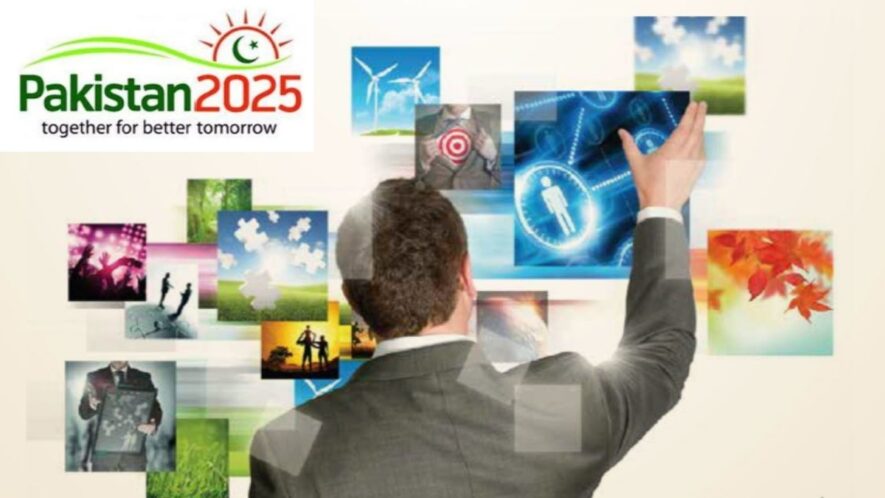Pakistan Vision 2025 is designed to represent an aspirational destination. It will serve as a critical guide-post for the development of an effective strategy and road-map to reach our national goals and aspirations. It is not meant to represent the resultant strategy and program itself. The Vision will be realized through strategies and programs defined in associated five-year and annual plans.
PILLAR I — Putting People First – Developing Human and Social Capital
- Increase Primary school enrolment and completion rate to 100% & literacy rate to 90%.
- Increase Higher Education coverage from 7% to 12 %, and increase no. of PhD’s from 7,000 to 15,000.
- Improve Primary and Secondary Gender Parity Index to 1, and increase female workforce participation rate from 24% to 45%.
- Increase proportion of population with access to improved sanitation from 48% to 90%.
- Reduce infant mortality rate from 74 to less than 40 (per 1000 births) and reduce maternal mortality rate from 276 to less than 140 (per 1000 births).
- Reduce the incidence/prevalence of Hepatitis, Diahorrea, Diabetes and Heart Disease by 50%.
- Pakistan will be World Champions in 2 sports and win at least 25 medals in the Asian games.
PILLAR II — Achieving Sustained, Indigenous and Inclusive Growth
- Become one of the largest 25 economies in the World, leading to Upper Middle Income country status.
- Reduce poverty level by half.
- Increase annual Foreign Direct Investment from USD 600 million to over USD 15 billion.
- Increase tax to GDP ratio from 9.8% to 18%.
PILLAR III — Governance, Institutional Reform and Modernization of the Public Sector
- Place in the top 50th percentile for Political Stability (from bottom 1 percentile), No Violence/Terrorism (from bottom 1 percentile), and Control of Corruption (from bottom 13th percentile) as measured by the World Bank’s Worldwide Governance Indicators.
PILLAR IV — Energy, Water and Food Security
- Energy: double power generation to 42,000 MW to provide uninterrupted and affordable electricity, and increase electricity access from 67% to over 90% of the population by 2025.
- Energy:
- Reduce average cost per unit by over 25% by improving generation mix (15%) and reducing distribution losses (10%);
- Increase percentage of indigenous sources of power generation to over 50%; and
- Address demand management by increasing usage of energy efficient appliances/products to 80%.
- Water: increase storage capacity to 90 days, improve efficiency of usage in agriculture by 20%, and ensure access to clean drinking water for all Pakistanis.
- Food: Reduce food insecure population from 60% to 30%.
PILLAR V — Private Sector-Led Growth
- Rank in the top 50 countries on the World Bank’s Ease of Doing Business Rankings.
- Increase Diaspora investment (via remittances) in private sector from USD 14 billion to USD 40 billion.
- Create at least 5 global Pakistani brands (having more than 50% sales coming from consumers outside Pakistan), and make ‘Made in Pakistan’ a symbol of quality.
PILLAR VI — Developing a Competitive Knowledge Economy through Value Addition
- Join the ranks of the top 75 countries as measured by the World Economic Forum’s Global Competitiveness Report.
- Triple labor and capital productivity.
- Improve Pakistan’s score on the World Bank Institute’s Knowledge Economy Index from 2.2 to 4.0, and increase internet penetration to over 50%.
- Increase the number of tourist arrivals to 2 million.
PILLAR VII — Modernizing Transportation Infrastructure and Greater Regional Connectivity
- Increase road density from 32 km/100 km2 to 64 km/ 100 km2, and share of rail in transport from 4% to 20%.
- Increase annual exports from US$ 25 billion to US$ 150 billon.
References
Macro, C. (2014). Pakistan Vision 2025 – Executive Summary. Islamabad: Ministry of Planning, Development and Reform, Government of Pakistan.
OTHER RELATED POSTS



